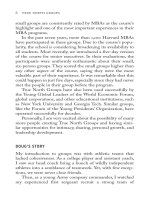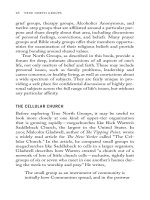Organizational Behavior and Organizational Behavior and Leadership
Bạn đang xem bản rút gọn của tài liệu. Xem và tải ngay bản đầy đủ của tài liệu tại đây (4.92 MB, 305 trang )
Organizational Behavior and Leadership Management
Essentials
Notice of Rights: Copyright © The Art Of Service. All rights reserved. No part of
this book may be reproduced or transmitted in any form by any means,
electronic, mechanical, photocopying, recording, or otherwise, without the prior
written permission of the publisher.
Notice of Liability: The information in this book is distributed on an “As Is” basis
without warranty. While every precaution has been taken in the preparation of the
book, neither the author nor the publisher shall have any liability to any person or
entity with respect to any loss or damage caused or alleged to be caused directly
or indirectly by the instructions contained in this book or by the products
described in it.
Trademarks: Many of the designations used by manufacturers and sellers to
distinguish their products are claimed as trademarks. Where those designations
appear in this book, and the publisher was aware of a trademark claim, the
designations appear as requested by the owner of the trademark. All other
product names and services identified throughout this book are used in editorial
fashion only and for the benefit of such companies with no intention of
infringement of the trademark. No such use, or the use of any trade name, is
intended to convey endorsement or other affiliation with this book.
Write a Review and Receive a Bonus Emereo
eBook of Your Choice
Up to $99 RRP – Absolutely Free
If you recently bought this book we would love to hear from you – submit
a review of this title and you’ll receive an additional free ebook of your
choice from our catalog at .
How Does it Work?
Submit your review of this title via the online store where you purchased
it. For example, to post a review on Amazon, just log in to your account
and click on the ‘Create Your Own Review’ button (under ‘Customer
Reviews’) on the relevant product page (you’ll find plenty of example
product reviews on Amazon). If you purchased from a different online
store, simply follow their procedures.
What Happens When I Submit my Review?
Once you have submitted your review, send us an email via
, and include a link to your review and a link to the
free eBook you’d like as our thank-you (from –
choose any book you like from the catalog, up to $99 RRP). You will then
receive a reply email back from us, complete with your bonus ebook
download link. It's that simple!
Also from Emereo Publishing and The Art of Service:
How to Develop, Implement and Enforce ITIL V3's Best Practices:
2009 Edition
2009 Revised Edition: ITIL® V3 comprehensive walk-though of the 5 Critical
Lifecycle Steps, core principles, best practices and support materials for adoption
and implementation of the ITIL® V3 IT Service Management Framework.
Also from Emereo Publishing and The Art of Service:
ITIL V3 Foundation Complete Certification Kit:
2009 Edition Study Guide Book and Online Course
2009 Edition ITIL V3 Foundation Certification exam prep guide, including
refreshed study guide, online eLearning program, new examples, instructions,
and cautionary advice.
ORGANIZATIONAL BEHAVIOR AND LEADERSHIP GUIDE
TABLE OF CONTENTS
INTRODUCTION ROADMAP ..................................................................................... 7
INTRODUCATION – ORGANIZATIONAL BEHAVIOR AND LEADERSHIP ............ 13
ORGANIZATIONAL BEHAVIOR AND LEADERSHIP .............................................. 31
POWERFUL, INFLUENCE AND PERSUASION ...................................................... 83
MANAGING CHANGE ........................................................................................... 107
BUSINESS RELATIONSHIP MANAGEMENT ....................................................... 127
SUPPORTING DOCUMENTS ............................................................................... 143
ORGANIZATIONAL BEHAVIOR SURVEY ......................................................... 145
MAPPING RESPONSIBILITIES.......................................................................... 149
TOPGRADING .................................................................................................... 159
DEVELOP YOUR LEADERSHIP SKILLS? ......................................................... 175
MOTIVATION...................................................................................................... 205
KPI’S ................................................................................................................... 223
VALUES, VISION AND MISSION STATEMENTS .............................................. 231
REWARD SYSTEMS .......................................................................................... 237
VIRTUAL TEAMS ............................................................................................... 243
MYTHS AND REALITIES OF VIRTUAL TEAMS ................................................ 245
TRUST BUILDING AND THE VIRTUAL TEAM .................................................. 247
THE POWER PROFILE ...................................................................................... 251
THE S CURVE .................................................................................................... 255
IMPLEMENTATION TOOLS ............................................................................... 259
AVOIDING PRESENTATION FRIGHT AND COMMON PITFALLS .................... 265
MANAGING CHANGE EFFECTIVELY ............................................................... 269
BRM: EXAMPLE JOB DESCRIPTION AND ADVICE ......................................... 273
BUSINESS RELATIONSHIPMENT MANAGEMENT RESPONSIBILITIES ........ 275
BRM METRICS AND REPORTS ........................................................................ 279
FURTHER INFORMATION .................................................................................... 289
Page 5
ORGANIZATIONAL BEHAVIOR AND LEADERSHIP GUIDE
Page 6
ORGANIZATIONAL BEHAVIOR AND LEADERSHIP GUIDE
INTRODUCTION ROADMAP
Many organizations are looking improve their understanding with regards to
organizational behavior and leadership, so they can implement/improve current
processes for recruitment, training, management and business planning, and as an
overall improvement to the structure and quality of the organization.
This document describes the contents of Organizational Behavior and Leadership
toolkit.
This guide is designed to answer a lot of the questions that organizational behavior
and leadership raises and provides you with useful guides, templates and essential,
but simple assessments.
Presentations can be used to educate or be used as the basis for management
presentations or when making business cases for implementation. These
presentations are packed full of everything you need to know with regards to
Organizational Behavior and Leadership.
The supporting documents and assessments will help you identify the areas within
your organization that require the most activity in terms of change and improvement,
and will enable you to improve your organizations organizational behavior and
leadership understanding and knowledge base.
This guide serves to act as a starting point. It will give you a clear path to travel. It is
designed to be a valuable source of information and activities.
Organizational Behavior and Leadership toolkit:
Flows logically;
Is scalable;
Provides presentations, templates and documents; and
Saves you time.
Page 7
ORGANIZATIONAL BEHAVIOR AND LEADERSHIP GUIDE
Step 1
Start by reviewing:
x
Introduction -Organizational behavior and leadership.
This provides a detailed and comprehensive introduction to Organizational Behavior,
Organizational Development and Quality of Work Life.
x
Introduction -Organizational behavior and leadership.
This focuses on building the right team, team concepts, choosing your teams and
specific concepts such as the Virtual Team. In addition, this presentation covers the
‘all you need to know’ ten steps of building powerful and influential teams.
x
Powerful, Influence and Persuasion.
This focuses on the definitions, arts and ways to work with power, influence and
persuasion. You can identify your own managerial style, or those of your manager.
There is detailed information on power sources and tactics on how you can use them
to your advantage. In addition, this presentation covers tips and ideas on how to
deliver a knockout presentation, and ensure you get what you want. Finally there is
specific and detailed information on the ethics of power, influence and persuasion –
to help you manage your working environment.
x
Managing Change.
This presentation focuses on the types and dimensions of changes and the different
approaches taken to deal with changes in the workplace. It helps you identify if your
organization is ‘change ready’ and what to do if it is not. There is a clear 7 step
guide to effectively and efficiently dealing with change and implementation.
Page 8
ORGANIZATIONAL BEHAVIOR AND LEADERSHIP GUIDE
x
Business Relationship Management.
This presentation focuses on the ITIL Service Management process of Business
Relationship Management. This process is centered on the alignment of the
business with the IT organization, and ensuring that activities take place to ensure a
clear line of communication and understanding is present between IT and the
customer.
Page 9
ORGANIZATIONAL BEHAVIOR AND LEADERSHIP GUIDE
Step 2
Below is an itemized list of the supporting documents and resources for easy
reference. You can use these documents and resources within your own
organization or as a template to help you in prepare your own bespoke
documentation.
Organizational Behavior and Leadership
x
Organizational Behavior Survey;
x
Top Grading;
x
Mapping Responsibilities;
x
KPI’s;
x
Develop your leadership skills;
x
Motivation;
x
Values, Vision and Mission Statements;
x
Rewards Systems;
x
Virtual Teams - A New Model;
x
Myths and Realities of Virtual Teams; and
x
Trust Building and the Virtual Team.
Powerful, Influence and Persuasion
x
The Power Profile;
x
The S Curve;
x
Rewards Systems;
x
Avoiding Presentation Fright and Common Pitfalls; and
x
Implementation Tools.
Page 10
ORGANIZATIONAL BEHAVIOR AND LEADERSHIP GUIDE
Managing Change
x
Managing Change Effectively;
x
Organizational Behavior Survey;
x
Mapping Responsibilities;
x
KPI’s; and
x
Rewards Systems.
Business Relationship Management
x
BRM job description;
x
BRM Responsibilities and Skills;
x
BRM Metrics and Reports; and
x
Mapping Responsibilities.
Page 11
ORGANIZATIONAL BEHAVIOR AND LEADERSHIP GUIDE
Page 12
ORGANIZATIONAL BEHAVIOR AND LEADERSHIP GUIDE
INTRODUCATION – ORGANIZATIONAL BEHAVIOR AND
LEADERSHIP
Aim of this Guide
x
Provide an introduction to the general principles of organizational behaviour
and leadership:
x
Provide user-friendly documents;
x
Improve your knowledge and understanding; and
x
Provide educational and awareness tools for staff within your organization.
Page 13
ORGANIZATIONAL BEHAVIOR AND LEADERSHIP GUIDE
Organizational Behavior (OB)
Organizational Behavior (OB) is the study and application of knowledge about how
people, both individuals and groups, act in organizations.
This is done by taking a systemic approach – interpreting people-organization
relationships in terms of the:
•
whole person;
•
whole group;
•
whole organization; and
•
Whole social system.
Page 14
ORGANIZATIONAL BEHAVIOR AND LEADERSHIP GUIDE
The organization’s base rests on management’s philosophy, values, vision and
goals. This in turn drives the organizational culture which is composed of formal
organization, informal organization and the social environment.
The culture determines the types of leadership, communication, and group dynamics
within the organization. Staff perceives this as the quality of work life, which directs
their degree of motivation.
Page 15
ORGANIZATIONAL BEHAVIOR AND LEADERSHIP GUIDE
Page 16
ORGANIZATIONAL BEHAVIOR AND LEADERSHIP GUIDE
Autocratic – The basis of this model is power with a managerial orientation of
authority. The employees in turn are oriented towards obedience and dependence
on the boss. The employee need that is met by subsistence. The performance result
is minimal.
Custodial – The basis of this model is economic resources with a managerial
orientation to money. The employees in turn are oriented towards security and
benefits and dependence on the organization. The employee need that is met with
security. The performance result in passive cooperation.
Supportive – The basis for this model is leadership with a managerial orientation of
support. The employees in turn are oriented towards job performance and
participation. The employee need that is met is status and recognition. The
performance result is awakened drive.
Collegial – The basis for this model is partnership with a managerial orientation of
teamwork. The employees in turn are oriented towards responsible behavior and
self-discipline. The employee need that is met is self-actualization. The
performance result is moderate enthusiasm.
Page 17
ORGANIZATIONAL BEHAVIOR AND LEADERSHIP GUIDE
The first model, Autocratic, has its roots in the industrial revolution. The managers of
this type of organization operate out of McGregors Theory X. The next three models
begin to build on McGregors Theory Y.
They have each evolved over a period of time and there is no one ‘best’ model. The
Collegial model should not be thought of as the last or best model, but as the
beginning of a new model or paradigm.
Page 18
ORGANIZATIONAL BEHAVIOR AND LEADERSHIP GUIDE
Theory X - In this theory, which many managers practice, management assumes
employees are inherently lazy and will avoid work if they can. Because of this,
workers need to be closely supervised and comprehensive systems of controls
developed.
A hierarchical structure is needed with narrow span of control at each and every
level.
Page 19
ORGANIZATIONAL BEHAVIOR AND LEADERSHIP GUIDE
Theory Y - In this theory, management assumes employees may be ambitious and
self-motivated and exercise self-control.
It is believed that employees enjoy their mental and physical work duties. They
possess the ability for creative problem solving, but their talents are underused in
most organizations.
Given the proper conditions, theory Y managers believe that employees will learn to
seek out and accept responsibility and to exercise self-control and self-direction in
accomplishing objectives to which they are committed.
Theory Y - Managers believe that, given the right conditions, most people will want
to do well at work. They believe that the satisfaction of doing a good job is a strong
motivation. Many people interpret Theory Y as a positive set of beliefs about
workers.
McGregor simply argues for managers to be open to a more positive view of workers
and the possibilities that this creates.
Page 20
ORGANIZATIONAL BEHAVIOR AND LEADERSHIP GUIDE
Page 21
ORGANIZATIONAL BEHAVIOR AND LEADERSHIP GUIDE
Organizational Development (OD)
Organization Development (OD) is the systematic application of behavioral science
knowledge at various levels, such as group, inter-group, organization etc. to bring
about planned change.
The OD objective is a higher quality of work life, productivity, adaptability, and
effectiveness. It accomplishes this by changing attitudes, behaviors, values,
strategies, procedures, and structures, so organizations can adapt to competitive
actions, technological advances, and the fast pace of change within the environment.
Page 22
ORGANIZATIONAL BEHAVIOR AND LEADERSHIP GUIDE
The seven characteristics of OD:
Humanistic Values: Positive beliefs about the potential of employees (McGregor's
Theory Y).
Systems Orientation: All parts of the organization, to include structure, technology,
and people, must work together.
Experiential Learning: The learners' experiences in the training environment should
be the kind of human problems they encounter at work. The training should NOT be
all theory and lecture.
Problem Solving: Problems are identified, data is gathered, corrective action is
taken, progress is assessed, and adjustments in the problem solving process are
made as needed. This process is known as Action Research.
Contingency Orientation: Actions are selected and adapted to fit the need.
Change Agent: Stimulate, facilitate, and coordinate change.
Levels of Interventions: Problems can occur at one or more level in the
organization so the strategy will require one or more interventions.
Page 23
ORGANIZATIONAL BEHAVIOR AND LEADERSHIP GUIDE
Quality of Work Life (QWL) is the favorableness or unfavorableness of the job
environment. The purpose is to develop jobs and working conditions that are
excellent for both the employees and the organization.
One of the ways of accomplishing QWL is through job design.
Page 24









